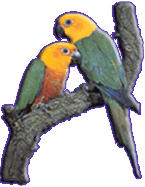|
|
| |
|
|
AUSTRALIAN RING-NECK
Barnardius Barnardi Barnardi |
|
|
| |
|
This species is not so popular and most of people never herd about it. Australian Ring-neck is Australian parrot native to southeast part of this continent. It is 35 cm long, so it belongs to the medium large group. Because of their color, they should be on the first pages in ornithology books, but they are not. Unbelievably, there are no even TV reportages on this bird. Maybe the reason is that these birds are not common in voliers and breeder houses, and it seems like nobody really cares about this amazing bird species. In the wild they are contrast to the dry and cruel environment, they are the only thing that gives a bit of colors to their habitat. They live on rare, tall, thorny trees of acacia, which is their food, too. Most of the day these birds are sitting on their trees occupied by themselves, it seems like they are aware of their beauty. |
|
|
Color variety and size are different from place to place. On the south, they are bigger and have very intensive colors, while on the north, they are smaller and the color that dominates is military green and yellow. On this page, you can read about Mallee ring-neck that comes from south and has more various colors. |
|
|
The basic color is intensive green, with lots of shades. Forehead is red, while the part just above the beak is reddish brown. Crown and upper part of the nape are green. On the neck, they have thick yellow ring. The cheeks are blue. Mantle and back are dark blue, while the rump is green. Belly is green like turquoise. On the middle of the belly, there is golden ring that has red ends. Wings are about 17cm long. Wing coverts are green and in the middle, they are yellow. Upperparts are blue and inner parts are black. Tail is 17 to 19 cm long. Middle tail feathers are olive green wit a bit of blue shade. On the upper side, tail is dark blue with white ends. Inner part of the tail is bright blue. Iris is dark brown and the narrow ring around the eyes is grey. The beak is 2 cm long colored in grey almost white. This species have two subspecies, pale green bernard and cloncure bernard. Genetical mutations made in captivety are isabel, blue, yellow, albino and pale yellow. Female is smaller than male, and has duller colors. They got the name over the yellow ring around the neck. |
|
|
Australian ring-necks are, as all Australian parrots, gentle by nature, and their song is quiet and soft. They are a bit louder in mating period. In the mating period, loud song of the male is the way to win a female. The mating period is in early spring, with the first sun. The female lays 3 to 5 eggs in the trunk of acacia trees. She will sit on eggs for 21 to 23 days. The young leave the nest 5 weeks after hatching, but stay with parents for the next month. After that month, young will start their own independent lives.
Even tough Australian ring-neck cannot learn to imitate human's talk, they are great pets. With life span around 30 years, gentle nature, bright and vivid colorings, nice song, lack of 2 gene 2 for destroying the house, with gracious walk and easy tamed personality Australian ring-neck is more than a good choice. It is maybe the best choice because not just, you will have all this, but you will have a bird that belongs to a very rare species. |
|
|
pair of Australian ring-necks
|
|
|
They feed on common seedish food for all medium-large parrots, minerals and vitamins are necessary, as well as fruit and vegetables. As they are very friendly, soon after getting one he will eat from your hand. This species uses legs when eating, and believe me they are very cute in that pose. |
| |
|
|
| |
|
|
| |
|
|
|
| |
|
|
|
|

